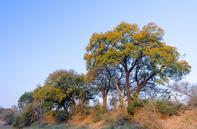
Name
Jackalberry or African ebony (Diospyros mespiliformis)Description
The Jackalberry tree can grow extremely tall, up to 25 m high. The circumference of its trunk measures about 4 m. The tree trunk grows upright, spreading its first branches high above the ground. Older trees have grooved and flattened ridges at the base which support them.
When the tree is young, its bark is a dark brown, which grey's as the tree ages. The bark’s deep horizontal grooves make it rough to the touch. The crown of the tree is thick, dark green and spreads wide. Its leaves are elliptical-shaped, about 13 cm (5.5 inches) long and 8 cm (3 inches) wide.
Young leaves have smooth or slightly curvy edges, whereas older leaves are shiny and have a leathery appearance – dark green on the top and lighter on the bottom. Young trees do not lose their leaves, but starts to shed its leaves in early spring as it ages. New leaves and twigs are covered in soft hairs, and vary from pink, orange to reddish in colour. These leaves come out from June to October.
Flowers and Fruit
The flowers of the jackalberry tree are small and unnoticeable. They are white to off-white in colour and sweet-smelling. Different genders of flowers grow on different trees. Females grow individually on hairy stalks whereas males grow in clusters, and only female trees carry fruit. Many animals feed on the fruit of the Jackalberry tree.
It is oval-shaped, about 2.5 cm in diameter and yellowish-green in colour. Five sepals of the flower’s calyx stay at the bottom of the fruit with their tips curling backwards. Inside the fruit are two to six wrinkly seeds. Once the tough skin is bitten through, one will taste the fruit’s chalky, floury texture and sweet, lemony flavour.
These fruits can be preserved, eaten fresh, dried or ground to make flour. A beer and brandy is also brewed from the jackalberry tree’s fruit. Its seeds are eaten as nuts. Once fully ripe, the fruit turns purple. A ripe fruit is rare to spot since animals such as nyalas, impalas, warthogs, hornbills and baboons eat them as soon as they can.
Its leaves are eaten by rhinos, giraffes, buffaloes, kudus and elephants, as well as the larvae of the bushveld emperor butterfly. The jackalberry tree gets its name from the jackal’s fondness of its fruit. During the tree’s fruit bearing period, the dung of the jackal is full of seeds from the fruit.
Uses
The trunks of the jackalberry tree is used to make canoes. Its hardwood has a fine grain, making it a good suit for flooring and quality furniture. The leaves, bark and roots contain tannin, which can act as an astringent, and is thereby used to stop bleeding. A concoction is made from the roots that serves as a remedy to ringworm, fever and diarrhoea, and is also considered a treatment for leprosy.Where they are found
In South Africa, the jackalberry tree can be found in Northern Limpopo. It is found throughout Africa, stretching from Namibia to Sudan to Senegal. These trees are most likely to be found in savannas or savannah woodlands, growing on termite mounds.
The termite mounds aerate the dense soil and is a source of moisture. The roots provide protection for the termites and are not eaten as termites only live on dead organic matter. After a jackalberry tree has been cut down, its wood is almost entirely resistant to termites.